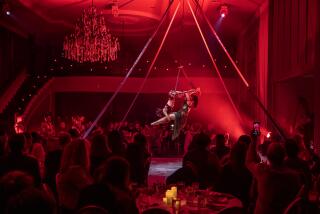COLUMN ONE : Dracula Is No Villain in Romania : Many are distressed to learn that their national hero, Vlad the Impaler, has been turned into a bloodsucking movie monster in the West.
- Share via
BORGO PASS, Romania — A neck-biting nobleman dispatched by 19th-Century literature to haunt this wind-swept outreach of Transylvania has stirred to life in the post-Communist era as the embodiment of a culture clash between patriotic Romanians and Hollywood.
Romanians, only recently acquainted with the Western version of Dracula, are spurning the caped count of Irishman Bram Stoker’s 1897 novel.
That’s because they fear the fictional vampire--and his celluloid successors--may taint the reputation of a real-life hero. Vlad Dracula the Impaler, a 15th-Century monarch renowned for making human skewers of his enemies, remains the monster of preference in his native land.
Since his emergence here less than two years ago, the character from Stoker’s Gothic novel has aroused strange, inhospitable emotions among the people of a region where the blood-drenched pages of history are more horrible than the wildest imaginations.
So although howling wolves still stalk this gorge, known to Romanians as Birgau or Tihuta, those who come to search the wild beauty of the Carpathian Mountains for vampires are more likely to get a lecture than a fright.
Westerners, obsessed with vampire lore, may conjure up images of smirking, evil-eyed Bela Lugosi from the 1931 film version of “Dracula,” or the campy depiction of blood lust released two years ago by Francis Ford Coppola.
But the Tinseltown tribulations over whether actor Tom Cruise is fit to play Lestat in the forthcoming film version of Anne Rice’s “Interview With the Vampire” would be lost on those who inhabit the land of Dracula’s birth.
For modern-day Transylvanians and most of the rest of this country, the real Vlad Dracula--whose savagery earned him the name Vlad Tepes (Vlad the Impaler)--is admired for his skilled, bestial conduct in terrifying Ottoman Turks from further encroaching on Christian Europe.
“Romanian history and folklore have been badly maimed,” insists Nicolae Paduraru, president of the Transylvanian Society of Dracula, founded in late 1992 to correct any misimpression that Romania was ever ruled by a fanged count. “Until 1972, no one ever made serious connection between the real and fictional Transylvania, and nobody connected Dracula to a real person.”
He attributes what Romanians see as a slight against their late leader to the publication 22 years ago of a book by two American historians who researched Stoker’s notes and journals to conclude his vampire character was loosely based on the medieval prince.
In a series of books published over the past two decades, Boston College professors Radu R. Florescu and Raymond T. McNally have detailed Vlad Dracula’s proclivity for subjugating military challengers by impaling them upright on wooden stakes; skinning alive promiscuous women as a lesson to those who would abandon family values, and nailing hats to the heads of visiting dignitaries who failed to doff them in a proper show of respect.
Even more outrageous, in the view of Romanian movie-goers, is Coppola’s “Dracula,” which unabashedly merges the real and fictional Draculas into a blood-besotted, time-traveling count.
The story of a nobleman who fed on victims’ blood reached here only last year, when Stoker’s novel was published for the first time in Romanian to coincide with the Bucharest premiere of Coppola’s movie.
Since the stunning revelation that foreigners do not share their esteem for the real Vlad Dracula, historians and budding capitalists have embarked on a campaign to set the record straight while cashing in on the Transylvanian mythology that was taboo during the Communist era.
Romanian admirers of The Impaler have devised dozens of programs of corrective tourism to re-educate the mythologically misguided.
Tracing Dracula’s footsteps is now one of Romania’s most popular tourist offerings, with Paduraru’s society serving as technical adviser to an array of state and private travel bureaus.
But contrary to Western expectations, the tours focus on the impaling prince to the virtual exclusion of his fictional successor. Most start with a visit to the hilltop castle in the village of Bran, a spired fortress overlooking a valley dividing the provinces of Wallachia and Transylvania.
The Impaler never lived there, but his father, Vlad “Dracul” (a title evolved from membership in the crusading Order of the Dragon), gained the castle as a customs outpost from which to tax Transylvanian merchants.
Vlad Dracula--or as his name translates, “son of the dragon”--ruled the Wallachian province from castles in Tirgoviste and Poienari that now lie in ruins.
Despite Bran’s remote association with the infamous monarch, the fortress’s profusion of gables and outlooks feeds the fantasy of Westerners who have their hearts set on touring what looks like a haunted castle. Romanians see the site as commemorating the protector’s role for which Vlad Dracula became famous.
“For Romanians, Dracula is a totally positive figure,” says Cristina Dinu, a 25-year-old computer programmer. “When he ruled, it was one of the most prosperous periods for Wallachia, and he succeeded in completely getting rid of thieves.”
Indeed, The Impaler inflicted such general terror that legend contends that a golden cup he left at a well went untouched for years as word of the hideous punishment for pilferage spread throughout the province.
He dealt with his military enemies with unparalleled savagery, his most infamous feat being the “forest of the impaled” he created on the approach to his stronghold of Tirgoviste as Turkish troops were about to attack in the summer of 1462. Confronted by the sight of 20,000 corpses of slaughtered, invading Turks--rotting on stakes that formed a two-mile wall of the dead--the sultan’s full army retreated in shame and terror.
Today, visitors to the village of Arefu, near the ruins of the castle at Poienari, are treated to a more flattering version of Vlad Dracula’s deeds. Around a late-night bonfire stoked to recreate the atmosphere of a medieval war camp, villagers tell how their forbears were rewarded with all the land around them for tipping off Vlad Dracula about another attack by the sultan’s forces.
“We want people to understand him as we do, as someone who saved Romania and much of Europe from conquest by the Turks,” says Carmen Piciorea of the ONT Carpati travel bureau, which arranges overnight stays for tourists with peasant families in Arefu.
Agencies also deliver clients to Vlad Dracula’s birthplace of Sighisoara for dramatic re-enactments of the last witch trials in Transylvania, performed in the house where the impaling prince was born in 1431. It now hosts a beer bar as well as occasional theater.
Romania’s most ambitious undertaking to clear up Vlad Dracula’s reputation is to take place in May, when scholars, folklorists and the merely curious are invited to the first World Dracula Congress.
Now free from the Communist-era strictures that banned discussion of the vampire myths, Romanian academics have called on foreign colleagues to come and share their thoughts about both the crusader and the count.
J. Gordon Melton, a scholar on cults and religions at UC Santa Barbara, believes the congress will help narrow the gap between vampire enthusiasts and Romanian patriots that developed during the Cold War.
“With the opening of Eastern Europe, this is the first time in a long time there will be an opportunity for Romanian and Eastern European scholars to get together with Western scholars,” says Melton, a professor, author and vampire buff.
Melton subscribes to the prevailing academic theory that Stoker drew on the life of Vlad Dracula as one of several sources for his character. And he predicts Romanian scholars will grow to accept this idea.
“There actually is a variety of opinion (on the vampire Dracula’s origin), but you have in Eastern Europe a very nationalized approach to their own background and history,” Melton says. “There is tremendous sensitivity because of doubts about their own history.”
Vlad Dracula’s dreadful reputation was preserved--some say embellished--by Saxon merchants of medieval Transylvania, who chronicled his purges and punishments in historical tracts that survived to serve as the basis for today’s scholarly writings on the life of The Impaler.
The main objective of the congress, organizers say, is to revive Vlad Dracula as a positive figure in Romanian history and to clearly separate him from vampires concocted by Stoker and Hollywood.
Although Dracula societies have existed in Western countries for decades, most notably a London group run by Stoker’s descendants, Romanians have only recently had any forum for pondering how history got mixed up with myth.
Amateur folklore enthusiasts like Vasile Olteanu, a retired painter who sells vampire medallions outside Bran castle, say the inspiration for Dracula’s blood-sucking behavior is a case of mistaken identity.
Storytellers have likely confused The Impaler with a deranged Transylvanian countess born a century later, Elizabeth Bathori, who was reputed to have bitten the necks of servant girls and bathed her own skin in virgin’s blood.
Not much time has passed since the vampire theme has been open to interpretation, but a few fledgling attempts to exploit the expectations of tourists are seen at this scenic pass where Stoker set his novel.
A vast, forbidding hostel built during late dictator Nicolae Ceausescu’s reign was renamed Hotel Dracula last year by its employees. A bat-like crest adorns the mock bell tower, just below neon lights advertising “disco bar.”
In a cellar room painted with unconvincing demons, hotel employees don capes, masks and what look like black satin shower caps to stage a hokey horror show in exchange for 200 lei --a performance of questionable value even at the price of 11 cents.
Blood-red Dracula vodka, Dracula wines, even a Dracula tea set are for sale at the inn’s kiosk, and a Dracula cutlet of rolled pork steeped in an indiscernible red sauce is pitched as the house specialty at the restaurant.
One Bucharest visitor recently on the trail of the vampire sawed determinedly through the leather-like entree, then contemplated the effects of the first bite.
“This,” he said, gesturing at his plate, “is the one experience here that is truly frightening.”
More to Read
The biggest entertainment stories
Get our big stories about Hollywood, film, television, music, arts, culture and more right in your inbox as soon as they publish.
You may occasionally receive promotional content from the Los Angeles Times.











